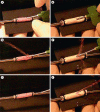The evolution of vascular tissue engineering and current state of the art
- PMID: 21996786
- PMCID: PMC3325604
- DOI: 10.1159/000331406
The evolution of vascular tissue engineering and current state of the art
Abstract
Dacron® (polyethylene terephthalate) and Goretex® (expanded polytetrafluoroethylene) vascular grafts have been very successful in replacing obstructed blood vessels of large and medium diameters. However, as diameters decrease below 6 mm, these grafts are clearly outperformed by transposed autologous veins and, particularly, arteries. With approximately 8 million individuals with peripheral arterial disease, over 500,000 patients diagnosed with end-stage renal disease, and over 250,000 patients per year undergoing coronary bypass in the USA alone, there is a critical clinical need for a functional small-diameter conduit [Lloyd-Jones et al., Circulation 2010;121:e46-e215]. Over the last decade, we have witnessed a dramatic paradigm shift in cardiovascular tissue engineering that has driven the field away from biomaterial-focused approaches and towards more biology-driven strategies. In this article, we review the preclinical and clinical efforts in the quest for a tissue-engineered blood vessel that is free of permanent synthetic scaffolds but has the mechanical strength to become a successful arterial graft. Special emphasis is given to the tissue engineering by self-assembly (TESA) approach, which has been the only one to reach clinical trials for applications under arterial pressure.
Copyright © 2011 S. Karger AG, Basel.
Figures




Similar articles
-
Mechanical properties of tissue-engineered vascular constructs produced using arterial or venous cells.Tissue Eng Part A. 2011 Aug;17(15-16):2049-59. doi: 10.1089/ten.TEA.2010.0613. Epub 2011 May 19. Tissue Eng Part A. 2011. PMID: 21457095
-
A combined method for bilayered vascular graft fabrication.J Mater Sci Mater Med. 2015 Feb;26(2):96. doi: 10.1007/s10856-015-5458-7. Epub 2015 Feb 5. J Mater Sci Mater Med. 2015. PMID: 25652773
-
Elastomeric PGS scaffolds in arterial tissue engineering.J Vis Exp. 2011 Apr 8;(50):2691. doi: 10.3791/2691. J Vis Exp. 2011. PMID: 21505410 Free PMC article.
-
Tissue engineered small-diameter vascular grafts.Clin Plast Surg. 2003 Oct;30(4):507-17. doi: 10.1016/s0094-1298(03)00069-5. Clin Plast Surg. 2003. PMID: 14621299 Review.
-
Scaffolds and Cell-Based Tissue Engineering for Blood Vessel Therapy.Cells Tissues Organs. 2016;202(5-6):281-295. doi: 10.1159/000448169. Epub 2016 Aug 23. Cells Tissues Organs. 2016. PMID: 27548610 Review.
Cited by
-
A novel polymeric fibrous microstructured biodegradable small-caliber tubular scaffold for cardiovascular tissue engineering.J Mater Sci Mater Med. 2021 Mar 1;32(2):21. doi: 10.1007/s10856-021-06490-1. J Mater Sci Mater Med. 2021. PMID: 33649939 Free PMC article.
-
Regenerative medicine: Clinical applications and future perspectives.J Microsc Ultrastruct. 2017 Jan-Mar;5(1):1-8. doi: 10.1016/j.jmau.2016.05.002. Epub 2016 May 24. J Microsc Ultrastruct. 2017. PMID: 30023231 Free PMC article. Review.
-
Tunable Elastomers with an Antithrombotic Component for Cardiovascular Applications.Adv Healthc Mater. 2018 Aug;7(16):e1800222. doi: 10.1002/adhm.201800222. Epub 2018 May 31. Adv Healthc Mater. 2018. PMID: 29855176 Free PMC article.
-
Electrospinning and emerging healthcare and medicine possibilities.APL Bioeng. 2020 Jul 14;4(3):030901. doi: 10.1063/5.0012309. eCollection 2020 Sep. APL Bioeng. 2020. PMID: 32695956 Free PMC article.
-
Future research directions to improve fistula maturation and reduce access failure.Semin Vasc Surg. 2016 Dec;29(4):153-171. doi: 10.1053/j.semvascsurg.2016.08.005. Epub 2016 Aug 26. Semin Vasc Surg. 2016. PMID: 28779782 Free PMC article. Review.
References
-
- Asher D.M. Bovine sera used in the manufacture of biologicals: current concerns and policies of the U.S. Food and Drug Administration regarding the transmissible spongiform encephalopathies. Dev Biol Stand. 1999a;99:41–44. - PubMed
-
- Asher D.M. The transmissible spongiform encephalopathy agents: concerns and responses of United States regulatory agencies in maintaining the safety of biologics. Dev Biol Stand. 1999b;100:103–118. - PubMed
-
- Barocas V.H., Girton T.S., Tranquillo R.T. Engineered alignment in media equivalents: magnetic prealignment and mandrel compaction. J Biomech Eng. 1998;120:660–666. - PubMed
-
- Becerra J., Andrades J.A., Ertl D.C., Sorgente N., Nimni M.E. Demineralized bone matrix mediates differentiation of bone marrow stromal cells in vitro: effect of age of cell donor. J Bone Miner Res. 1996;11:1703–1714. - PubMed
-
- Berglund J.D., Mohseni M.M., Nerem R.M., Sambanis A. A biological hybrid model for collagen-based tissue engineered vascular constructs. Biomaterials. 2003;24:1241–1254. - PubMed
Publication types
MeSH terms
Grants and funding
LinkOut - more resources
Full Text Sources
Other Literature Sources

